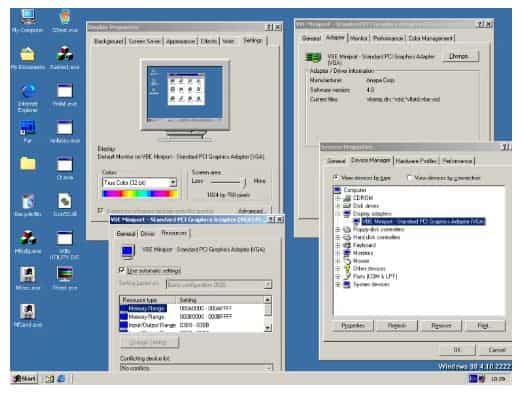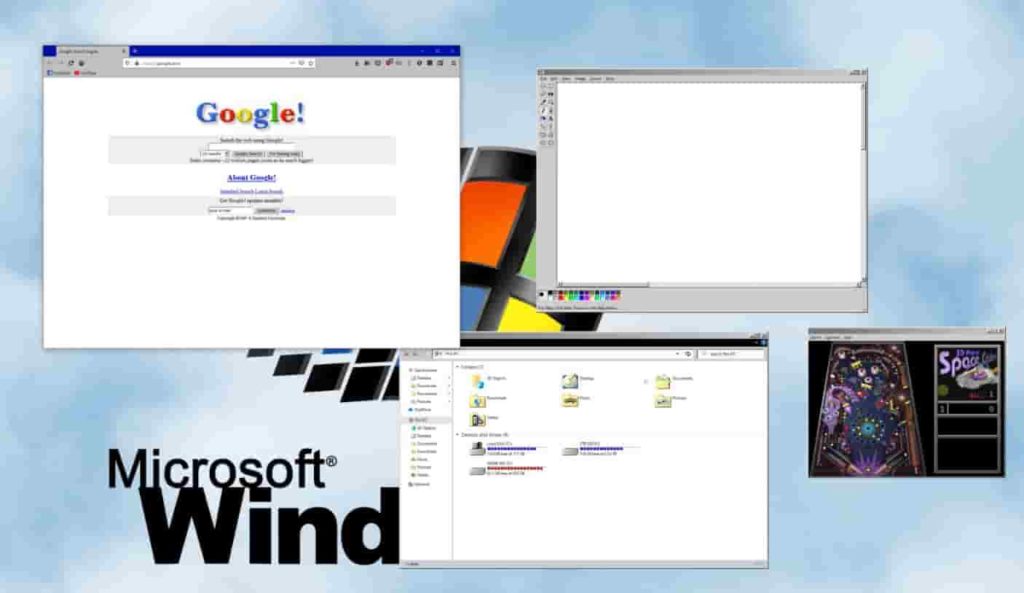
Released back in 1998 comes with a GUI-based interface. It got released as part of the 9x series of operating systems which included its predecessor, Windows 95. This came out for both the 32 and 16-bit versions just like older ones it was based on Disk Operating System commonly known as DOS; a command-line OS that was developed by Microsoft. It came out in 1998 and in the same year was put on sale throughout the globe.
After this came Windows 98 SE ISO Free Download which means it was the Second Edition that came out in the year 1999. Both of these were supported till 2002, buyers got extended support till 2006.
This is the second installation in the 9x series of OS by Microsoft. This was a successor to the highly popular yet successful Win 95. It was quite popular among users for being lightweight, efficient, and customizable. For playing games, this was deemed to be the best operating system.
It came in with many changes, upgrades as well as new applications. The most notable changes included web support. It came out with major improvements for web integrations and carried a lot of applications that were related to the internet. Moreover, it also came with some networking enhancements.
Less talking now, more showing!
Windows 98 ISO Image Useful Features

Web View – Customisation
- Performed single-click navigation.
- Provided a way to view and customize the appearance of folders.
- Added fifth icon view to the original four views which were small and large icons, list as well as details.
Keep in mind that this should not be confused with Win98’s many hooks into the internet. With this get to the web anytime you want from anywhere in Win98, even with this being turned off. Moreover, this can also be enjoyed without any internet connection. It carries a misnomer. Browser View would be a better name as it really enabled users to navigate as well as view files on the system with a browser-like interface.
Taskbar and Start Menu – A new approach
Taskbar, being a smarter innovation is quite better in Internet Explorer 4.0 and Win98. Microsoft has the new version very close to the “if it’s not broken, don’t fix it” school of thought. There is no mind-bending, radical overhaul but you would see the addition of significant and beneficial enhancements.
The new web-savvy features were quite helpful for the users. With this, the favorites folder was found there on the start menu, under this, a “Find…On the Internet” choice took users to search the official website.
Additions to the start menu were quite noticeable whereas the taskbar itself was where the action is. They solved the issues of Win95 users who wanted to drag and drop document, app, and folder shortcuts onto the taskbar directly, the way they could with the Office97 Software.
Scripting and Automation – Looking ahead
WSH known as the Windows Scripting Host was a successor to the venerable DOS batch file format. This was a standard feature in all of the versions of its OS. It incorporated both the JavaScript and VBScript engine which appeared in Internet Explorer and Internet Information Server (IIS), allowing batch files to be written down in either language.
The best thing about this one is that it supported all the standard features of both languages, including subroutines and functions, arrays, and variables. True if/else statements and other flow-control statements allowed sophisticated looping and a lot more.
It also provides two complete versions of Scripting Host. One (CSCRIPT.EXE) is a command-line utility that is able to run in a DOS box under either NT 5.0 or Memphis. Whereas the other one (WSCRIPT.EXE) is a standard 32-bit app. Anyone can be chosen as a default scripting host (one that is able to run automatically when a user double-clicks or runs a script file). The best thing is that both versions support all VBScript, JavaScript, and WSH features.
READ ALSO: Download Windows XP Service Pack 3 ISO Image for Virtualbox.
Multimedia Support – Movies and Music
Multimedia Extensions (MMX) was a set of 57 new instructions that Intel had added to specific x 86 processors in order to speed up all the tasks related to multimedia. Every instruction is sped up processing by abbreviating the various instructions that previous processors require to accomplish a provided task.
Processors that are enhanced with MMX include Intel’s P55C Pentium and Pentium II, AMD’s, and Cyrix’s 6x86MX. This was the first OS to provide support to MMX which meant improvised performance for image processing, video conference, audio, video, and similar functionalities.
File System – Easier navigation structure
A new yet improved FAT32 (File Allocation Utility) file system was introduced by Microsoft in this. This is used to free up space hard disk space by allocating space quite more efficiently than the previous version. With this users can get an average of 28% more disk space without even buying new hardware, and launch programs faster when you combine this with Win98 Disk Defragmenter.
Moreover, with this users can work with a very large disk space which is over two terabytes it is quite easier with this as they can represent the disk with a single drive letter other than splitting it in two.
Performance – It was much faster and more responsive
Microsoft came out with a good way to make this work fast. The Disk Defragmenter Optimization Wizard is used to track programs that are run most often and then cluster these on the fastest part of the hard disk. Now, to use this you need to close down all the apps and then launch the wizard. It lets users choose programs that run frequently, launch them, and note down which files are accessed from the hard disk for each.
WinAlign is one of the key pieces to its performance puzzle; this is a utility that is used to align the contents of the program files so they are able to load faster- 20% faster or even more. With speedy access to apps and data used, users are able to trim unproductive wait times.
The load times are slower with unaligned code as Win98 must copy it from the disk cache page to a brand new page aligned on a 4 KB boundary. The aligned programs shall run fast as it runs the code directly from disk-cache pages where they were loaded.
Windows 98 Minimum System Requirements

The computer hardware needs to meet the following requirements to run it:
- CPU: 486DX/77 MHz or a higher processor.
- Memory: 16 Megabytes: more memory means more memory performance.
- HDD: installation needs approximately 195 MB of hard disk space but might range between 120 MB to 295 MB, depending on the system configuration and option chosen to install.
- Drives: DVD-ROM or CD-ROM drive.
- Display Monitor: VGA or higher resolution monitor.
- Extra Hardware: Mouse or compatible pointing device.
- Storage Space: Space required depends upon the installation methods and components that are selected but the virtual memory and system utilities along with the driver shall be taken into consideration:
Did you know?
->Upgrading from Win 95 (FAT16) or 3.1 (FAT): 140–400 MB (typically 205 MB).
->New installation (FAT32): 140–255 MB (typically 175 MB).
- 16 MB of RAM: 24 MB is recommended, it is possible to run on 8 MB machines with /nm option which is used during the process of installation.
Users are able to bypass the hardware requirements checks with an undocumented /NM setup switch. This allows installation on the system with processors as old as 80386.
Win98 VCACHE is not designed or developed to handle more than 1.0 GB of RAM without little changes.
Both this and Win98 SE have problems running on hard drives that are bigger than 32 GB and specific Phoenix BIOS systems. The software update has fixed this shortcoming. Moreover, windows till XP without the service pack is not able to handle hard drives that are over 137 GB in size with default drivers, as of missing 48-bit LBA support – disc data corruption is likely. The third-party patches are there to fix this in 9x as well.
Download Windows 98 / Windows 98 SE ISO Free Full Version – Virtualbox, VMware, and Bootable USB

As you now have know-how about all the unique features and would like to try it out for yourself, download Windows 98 First Edition or Second Edition ISO free in 32-bit and 64-bit versions:
- In the first step, you need to download the Disc Image file.
- Users can now use a pen drive or even burn the file to a disk that uses software like Power ISO.
- After this boot into the USB drive or DVD/CD and follow the provided installation instructions to install this on your system.
Users can also install it on a virtual machine using VirtualBox or any similar software as an alternate. You need to be sure that your system can support virtualization and boot up a virtual machine with this as the virtual disk and follow instructions to install it on a virtual machine.
If you want to activate the installation, here is a product key that works:
License: Free Trial.
RW9MG-QR4G3-2WRR9-TG7BH-33GXBDownload Windows 98/Windows 98 SE ISO 32-Bit/64-Bit













Worked on VirtualBox for me.
vmware?
Hi, it should work on Workstation too.